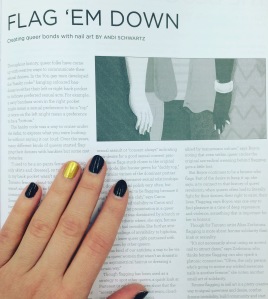
**The following is a longer version of a femme flagging article I wrote for Shameless magazine. Check out the Shameless version, “Flag ‘Em Down” (and another story of mine!) in the Alternative Beauty issue, Winter 2015.**
Through history, queer folks have had come up with creative ways to communicate their desires. In the 1970s, gay men developed the “hanky code,” a system that required individuals to hang coloured bandanas in either their left or right back pocket. The colours or prints of the bandanas and their placement indicated which sexual acts the person was seeking.
The hanky code was a way to cruise under the radar, according to the blog Stuff Queer People Need to Know. Many queer people started flagging their desires, but some met certain obstacles.
“I used to be a no-pants femme, so tucking a hanky in my pocket wasn’t an option,” says Toronto femme-about-town Carly Boyce.
Femmes had to remix the hanky code to come up with their own system of flagging that could work with any outfit. Femmes flag with nail polish, fascinators or brooches made out of bandanas, or with bandanas tied around their wrists, necks, or purses, according to Boyce.
“For years I only flagged with my nails, and I still do that a lot,” adds Boyce.
Flagging with nail polish usually looks like one or two fingers painted a different colour. The accent nail is used to signal queerness generally, but sometimes the accent colour correspond to the hanky code or holds another specific meaning.
Julia Caron was part of a loose collective of femmes that started the Tumblr Femme Flagging in 2012. The blog was a place to share tips on where to buy cheap nail polish, discuss the politics of flagging, and, of course, show off their nails.
Caron recalls users submitting photos of their nails with flags like “iridescent gold for strength through vanity,” “survivor stripes” or “consent always.” Some flags stuck closer to the original hanky code, like hunter green for “daddy top.”
“I don’t wear nail polish very often, but when I did I wanted to be flagging because it was fun! It felt like a club,” says Caron. “It was kind of our antidote, a way to be visible as queer women that wasn’t as dramatic as an asymmetrical haircut or dressing a certain way.”
Caron is referring to the invisibility many femmes experiences in queer and mainstream circles. She attributes her experiences of invisibility to coming out in a queer community that was grappling with biphobia and dominated by a butch aesthetic.
“The places I have been encouraged and felt the most accepted have been in online spaces,” she says.
The Tumblr was based around the idea of creating an accessible way of flagging your identity or desire to people “in the know.”
This gets complicated considering the “accent finger” in manicures went mainstream. Though Caron isn’t sure which came first, Boyce is confident that femme flagging was co-opted.
“Which is, like, so par for the course of how innovations get consumed and decontextualized by mainstream culture,” says Boyce, noting that even within queer circles the original sex-radical meaning behind flagging gets a little lost.
Part of the desire to keep up with the tradition of flagging, at least for Boyce, is to connect to that history of queer revolution, when queers often had to literally fight for their lives and desires. Flagging was one way to find pleasure in a time of deep repression and violence, says Boyce.
For Toronto artist Alize Zorlutuna, flagging is about femme solidarity.
“It’s not about necessarily using them to attracting dates. The only person who’s going to notice my wicked awesome nails is another femme,” she says.
This past summer, Boyce and Zorlutuna hosted Femme Futures in Toronto, an event combining manicures, a way femmes often connect and care for each other, and tarot readings, a therapeutic practice, to create a femme-centered public space.
“A piece of it is around femme visibility because so many queer femmes, not exclusively all, but so many can go unseen in public space, it feels valuable to create space specifically for femmes to be visible,” says Zorlutuna.
The readings inspired the manicures, so healing symbols often made their way onto femmes’ nails, she says.
“When they looked down on their hands there was a reminder of that exchange and whatever came out of it,” says Zorlutuna, noting femmes said the experience stuck with them for weeks.
“That was so moving for me. There’s this intimacy created in this exchange that can be quite vulnerable.”
Despite going mainstream, nail flagging can still get you noticed in certain circles, and is a good way to start a conversation about queerness or kink.
“I love to ask people if they’re flagging, and I love it when people ask me if I am,” says Boyce.
Caron remembers starting a conversation with a girl in bar just because of her nails.
“I wouldn’t have approached her if I hadn’t seen that manicure,” she says.
Starting the conversation doesn’t have to lead anywhere. Flagging does have basic ground rules, which are outlined on the blog Flagging Opinicus Rampant. The first two are: “Flagging is not consent” and “Flagging means being cool with being propositioned, being rejected, and having the capacity to reject.”
Nail art is a creative way to signal queerness and desire, combat femme invisibility, build community, and start important conversations about sexuality and consent. Can your manicure do that?
One thought on “Colour Coding: Creating Queer Bonds with Nail Art”